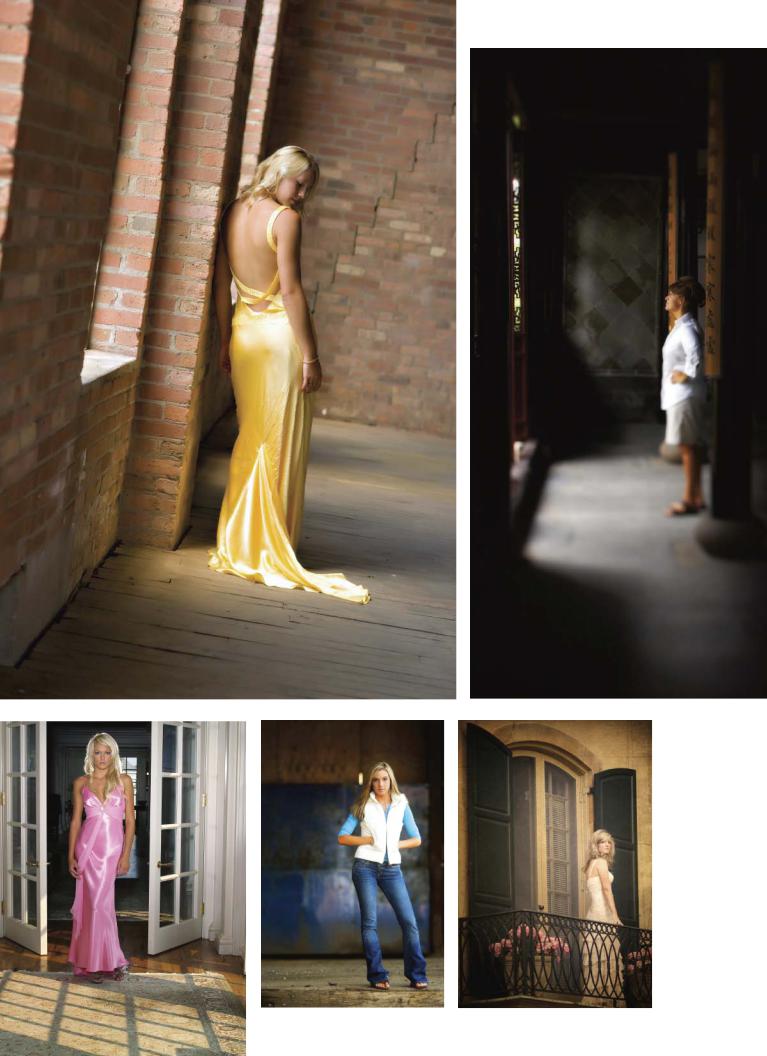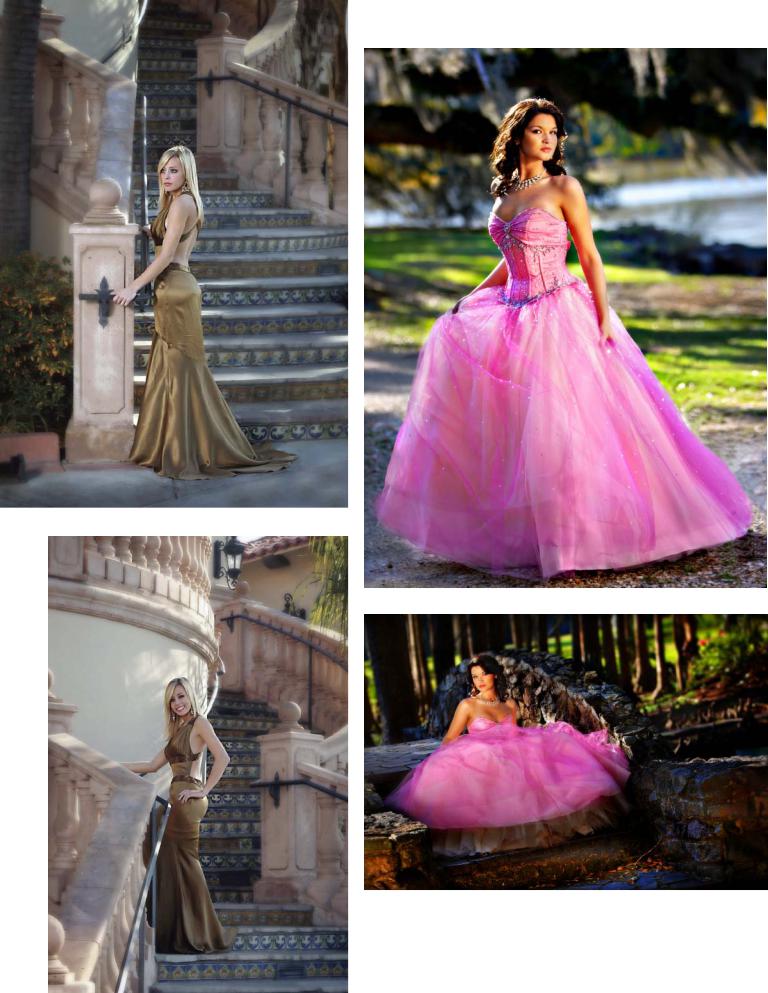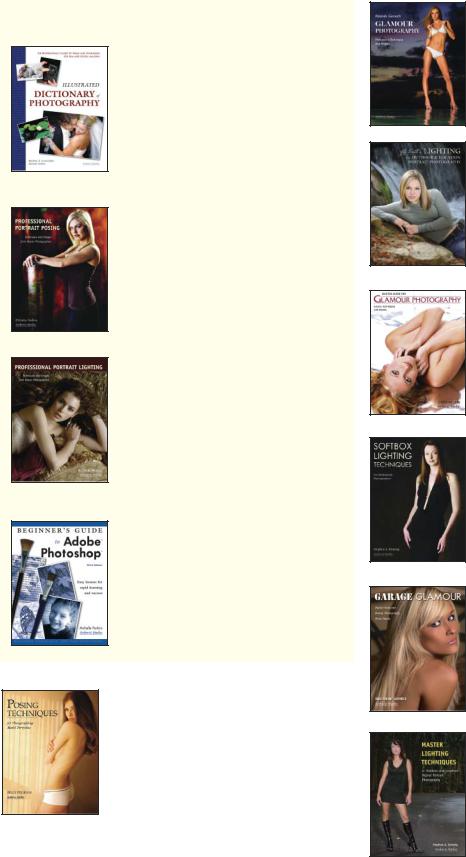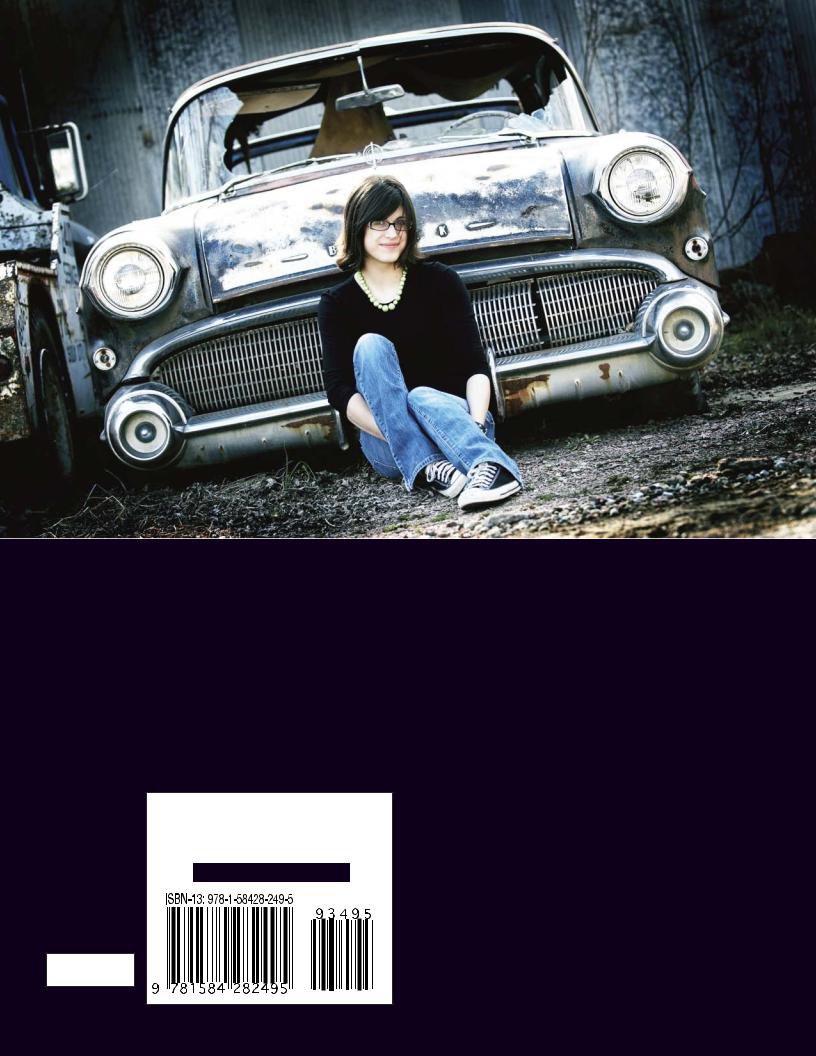
500_poz_dlya_fotografii_zhenschin
.pdf
PLATE 490. PHOTOGRAPH BY VICKI TAUFER. |
PLATE 491. PHOTOGRAPH BY VICKI TAUFER. |
PLATE 492 (FAR LEFT).
PHOTOGRAPH BY ROLANDO
GOMEZ.
PLATE 493 (CENTER).
PHOTOGRAPH BY JEFFREY
AND JULIA WOODS.
PLATE 494 (RIGHT).
PHOTOGRAPH BY JEFFREY
AND JULIA WOODS..

PLATE 495. PHOTOGRAPH BY WES KRONINGER.
PLATE 496. PHOTOGRAPH BY TIM SCHOOLER. |
PLATE 497. PHOTOGRAPH BY TIM SCHOOLER. |

PLATE 498. PHOTOGRAPH BY JEFF SMITH.
PLATE 499. PHOTOGRAPH BY TIM SCHOOLER.
PLATE 501. PHOTOGRAPH BY TIM SCHOOLER.
PLATE 500. PHOTOGRAPH BY JEFF SMITH.
This section covers the fundamental rules of traditional posing—techniques that are illustrated in many of the images in this book. While these rules are often intentionally broken by contemporary photographers, most are corner-
stones for presenting the human form in a flattering way.
Types
There are three basic types of poses, each defined by how much of the length of the subject’s body is included in the image. When including less than the full body in the frame, it is recommended that you avoid cropping at a joint (such as the knee or elbow); this creates an amputated look. Instead, crop between joints.
Head and Shoulders Portraits (or Headshots). Portraits that show the subject’s head and shoulders. If the hands are lifted to a position near the face, these may also be included.
Waist-Up Portraits. Portraits that include the subject’s head and shoulders along with at least some of the torso. In portraits of women, these images are often cropped just below the bustline or at the waist. Waist-up portraits are sometimes considered a type of headshot.
Three-Quarter-Length Portraits. Portraits that show the subject from the head down to the mid-thigh or midcalf. In some cases, one foot may be visible.
Full-Length Portraits. Portraits that show the subject from the head down to the feet (or at least the ankles). In some cases, only one foot may be visible.
Facial Views
Full Face View. The subject’s nose is pointed at the camera.
Seven-Eighths View. The subject’s face is turned slightly away from the camera, but both ears are still visible.
Three-Quarters or Two-Thirds View. The subject’s face is angled enough that the far ear is hidden from the camera’s view. In this pose, the far eye will appear smaller because it is farther away from the camera than the other eye.
APPENDIX
Posing Basics
The head should not be turned so far that the tip of the nose extends past the line of the cheek or the bridge of the nose obscures the far eye.
Profile View. The subject’s head is turned 90 degrees to the camera so that only one eye is visible.
The Shoulders
Especially in portraits of women, the subject’s shoulders should be turned at an angle to the camera. Having the shoulders face the camera directly makes the person look wider than he or she really is and can yield a static composition. In women’s portraits, squaring the shoulders to the camera can give the image a less feminine look (which is sometimes done intentionally to create an assertive mood).
The Head
Tilting the Head. Tilting the head slightly produces diagonal lines that can help a pose feel more dynamic. In women’s portraits, the head is traditionally tilted toward the near or high shoulder, but this rule is often broken. Most photographers agree that the best practice is to tilt the subject’s head in the direction that best suits the overall image and most flatters the subject.
Chin Height. A medium chin height is desirable. If the chin is too high, the subject may look conceited and her neck may appear elongated. If the person’s chin is too low, she may look timid and appear to have a double chin or no neck.
Eyes. In almost all portraits, the eyes are the most important part of the face. Typically, eyes look best when the eyelids border the iris. Turning the face slightly away from the camera and directing the subject’s eyes back toward the camera reveals more of the white of the eye, making the eyes look larger.
Arms
The subject’s arms should be separated at least slightly from the waist. This creates a space that slims the appearance of
123
the upper body. It also creates a triangular base for the composition, leading the viewer’s eye up to the subject’s face.
Arms should always be articulated and never allowed to simply hang at the subject’s sides. Simply bending the elbows creates appealing diagonal lines in your composition— and placing these carefully can help direct the viewer of the image to the subject’s face.
Most portrait photographers request that the subject wear long-sleeved tops; even if the subject is thin, bare upper arms rarely render attractively in portraits.
Hands
Keep the hands at an angle to the lens to avoid distorting their size and shape. Photographing the outer edge of the hand produces a more appealing look than showing the back of the hand or the palm, which may look unnaturally large (especially when close to the face). Additionally, it is usually advised that the hands should be at different heights in the image. This creates a diagonal line that makes the pose more dynamic.
Wrist. Bending the wrists slightly by lifting the hand (not allowing it to flop down) creates an appealing curve that is particularly flattering in women’s portraits.
Fingers. Fingers look best when separated slightly. This gives them form and definition.
Props. Hands are often easiest to pose when they have something to do—either a prop to hold or something to rest upon.
Chest
In portraits of women, properly rendering this area is critical. Selecting a pose that places the torso at an angle to the camera emphasizes the shape of the chest and, depending on the position of the main light, enhances the formrevealing shadows on the cleavage. Turning the shoulders square to the camera tends to flatten and de-emphasize this area. Good posture, with the chest lifted and shoulders dropped, is also critical to a flattering rendition.
Waist and Stomach
Separating the arms from the torso helps to slim the waist. In seated poses, a very upright posture (almost to the point of arching the back) will help to flatten the stomach area, as will selecting a standing pose rather than a seated one. It is also generally recommended that the body be angled away from the main light. This allows the far side of the body to fall into shadow for a slimming effect.
Legs
Whether the subject is standing or seated, the legs should be posed independently rather than identically. Typically, one leg is straighter and used to support the body (or in a seated pose, to connect the subject to the floor). The other leg is bent to create a more interesting line in the composition.
Standing. Having the subject put her weight on her back foot shifts the body slightly away from the camera for a more flattering appearance than having the weight distributed evenly on both feet. Having a slight bend in the front knee helps create a less static look.
Seated. When the subject is sitting, her legs should be at an angle to the camera. Allowing for a small space between the legs and the chair will slim the thighs and calves.
One Leg in Profile. In portraits of women where the legs are bare, it is desirable to show the side of at least one leg. This better reveals the shape of the ankle and calf.
Hips and Thighs
Most female subjects are concerned about this area. For the slimmest appearance in a standing pose, turn the hips at an angle to the camera and away from the main light. In a seated pose, have the subject shift her weight onto one hip so that more of her rear is turned away from the camera.
Feet
Feet often look distorted when the toes are pointed directly at the camera. It is best to show the feet from an angle. In portraits of women, the toes are often pointed (or the heels elevated, as they would be in high-heeled shoes). This flexes the calf muscles, creating a slimmer appearance and lengthening the visual line of the subject’s legs.
124
The Photographers
Steven Begleiter (www.begleiter.com). Steven Begleiter is an award-winning freelance photographer and studio owner based in Missoula, MT, who began his career as a photo assitant to Annie Leibowitz and Mary Ellen Mark. Before moving to Montana, Steven operated a successful commercial photography businesses in New York City and Philadephia, winning assignments from international magazines, Fortune 500 companies, and national advertising campaigns. Steven is the author of Fathers and Sons: Photographs
(Abbeville Press), The Art of Color Infrared Photography, The Portrait Book, and 50 Lighting Setups for Portrait Photographers (all from Amherst Media) and currently teaches at the Rocky Mountain School of Photography.
Dan Brouillette (www.danbrouillette.com). A native of Soiux City, IA, Dan Brouillette became interested in photography as a student at Iowa State University, where the imaging software on his roommate’s computer held much more intrigue than his own biology textbooks. When a family friend asked him to take her senior portraits, he was eager to give it a try—and the results were so good that each subsequent year he received increasing numbers of calls from other seniors looking for his unique images. Four years later, Dan has opened a complete photo studio and is quickly catching the attention of photo editors and art directors with his fresh editorial/commercial style.
Stephen Dantzig (www.dantzigphotography.com).
Stephen Dantzig, who specializes in fashion, beauty, and corporate photography, is a nationally renowned lighting expert and author of Lighting Techniques for Fashion and Glamour Photography, Mastering Lighting Techniques for Outdoor and Location Digital Portrait Photography, and Softbox Lighting Techniques for Professional Photographers (all from Amherst Media). He has written more than fifty magazine articles on photographic lighting and ethics for Rangefinder, Professional Photographer, PC Photo, Studio Photography & Design, and www.prophotoresource.com. He resides in Honolulu, HI.
Rick Ferro and Deborah Lynn Ferro (www.rickferro
.com). Rick Ferro and Deborah Lynn Ferro operate Signa-
ture Studio, a full-service studio that provides complete photography services for families, portraits, children, highschool seniors, and weddings. In addition to the acclaim they have received for their images, Rick and Deborah are also popular photography instructors who tour nationally, presenting workshops to standing-room-only audiences (for more on this, visit www.ferrophotographyschool.com). Rick and Deborah have also authored numerous books, including
Wedding Photography: Creative Techniques for Lighting, Posing, and Marketing and Artistic Techniques with Adobe Photoshop and Corel Painter, both from Amherst Media.
Rolando Gomez (www.rolandogomez.com). Rolando Gomez is a highly published photojournalist who was selected in 1994 by the Department of Defense as one of the top five military photographers worldwide. After nearly a decade of high-level employment with the Air Force News Agency, Rolando left to pursue his passion: glamour photography. He is the founder of www.GarageGlamour.com, which is visited by over half a million people each month. This has led to a successful career conducting international glamour workshops and three popular books: Garage Glamour: Digital Nude and Beauty Photography Made Simple, Rolando Gomez’s Glamour Photography, and Rolando Gomez’s Posing Techniques for Glamour Photography, all from Amherst Media.
Wes Kroninger (www.weskroninger.com). Wes Kroninger is a professional photographer who established his career in Baton Rouge, LA, until relocating to Los Angeles in 2008. Kroninger, who specializes in commercial beauty photography, describes himself as an “MTV and Atari kid” and feels that this is reflected in how he pairs classic photographic skills with an edgy, contemporary sensibility. Kroninger’s fresh and bold imagery has been featured in American Salon, Rolling Stone, and Rangefinder. His images have also won numerous awards for him and his clients.
Chris Nelson (www.fallcreekphoto.com). A former photojournalist and reporter, Chris Nelson used to supplement his small-market wages shooting weddings, advertis-
125
ing images, and senior portraits—until he discovered he enjoyed his sideline more than his main job. Today, he operates Fall Creek Portrait Design, located in Fall Creek, WI. He has won numerous awards for his portrait photography and is the author of Master Guide for Glamour Photography, from Amherst Media.
BIlly Pegram (www.billypegram.com). Fashion, editorial, and commercial photographer Billy Pegram is known as a shooter who pays attention to detail and always captures amazing results. In addition to photographing assignments for FILA, Lord of the Dance, and celebrities like John Nordstrom and Booth Gardiner, Billy has directed and produced over a hundred videos for American College of Sports Medicine in conjunction with major sponsors such as Reebok, Gatorade, YMCA Corporation, and Stairmaster. He is also the author of Professional Model Portfolios, Posing Techniques for Photographing Model Portfolios, and Fashion Model Photography: Professional Techniques and Images, all from Amherst Media.
Hernan Rodriguez (www.hernanphotography.com).
The recipient of over twenty international photography awards in the past three years alone, Hernan Rodriguez operates a successful studio in the heart of Los Angeles’ San Fernando Valley. There, he juggles a steady roster of commercial, product, and celebrity photography, along with portraiture for families, children, and graduates. He has art directed and photographed advertising campaigns for Guess Clothing, Tanline CA, Comfort Zone, and Corona (to name just a few). He has also been featured in Rangefinder, Studio Photography, and Photoshop User magazines.
Tim Schooler (www.timschooler.com). Tim Schooler Photography is an award-winning studio, located in Lafayette, LA, that specializes in cutting-edge high-school senior photography. Tim’s bold and dynamic images are so popular that his sessions book solid almost instantly—in fact, he often has several hundred seniors on his waiting list! Tim’s work has been published internationally and he has been the subject of numerous profiles in Rangefinder magazine. His signature images and techniques have also been featured prominently in numerous books on professional portrait photography.
Jeff Smith (www.jeffsmithphoto.com). Jeff Smith is an award-winning senior photographer from Fresno, CA. He owns and operates two studios in Central California and is well recognized as a speaker on lighting and senior photography. He is the author of many books, including Corrective Lighting, Posing, and Retouching for Digital Photographers
and Jeff Smith’s Lighting for Outdoor & Location Portrait Photography (both from Amherst Media), and Senior Contracts (self-published).
Cherie Steinberg Cote (www.cheriefoto.com). Cherie Steinberg Cote began her photography career as a photojournalist at the Toronto Sun, where she had the distinction of being the first female freelance photographer. She currently lives in Los Angeles and has been published in Grace Ormonde, Los Angeles Magazine, and Town & Country. She is also a Getty Image stock photographer and an acclaimed instructor who has presented seminars to professional photographers from around the country.
Vicki Taufer (www.vgallery.net). Vicki Taufer, with her husband Jed, is the co-owner of V Gallery, a prestigious portrait studio in Morton, IL. In just three years, the studio has grown from the cramped basement of the couple’s house to its current home in a 4,000-square-foot space with eight employees. Vicki has received national recognition for her portraits and is an award winner in WPPI (Wedding and Portrait Photographers International) print competitions. She is also a popular photography instructor, who has led workshops both nationally and internationally—including a trip to South Korea.
Marc Weisberg (www.mwphoto.net). Marc holds a degree in fine art and photography from UC–Irvine and also attended the School of Visual Arts in New York City. His studio, located in Newport Beach, CA, specializes in wedding, portrait, and commercial photography but also photographs editorial and fashion work on a regular basis. Marc’s images have earned over fourteen national and international awards and have been featured in numerous magazines, including Riviera, Los Angeles Confidential, The Knot, Ceremony, and Rangefinder. His work had also appeared in four books from Amherst Media.
Jeffrey and Julia Woods (www.portraitlife.com). Jeffrey and Julia Woods are award-winning wedding and portrait photographers who work as a team. They operate a successful wedding and portrait studio that specializes in highly personalized images that reflect the tastes and experiences that make each client unique. Their elegant images have been featured in Rangefinder magazine and in numerous photography books. In addition, their acclaimed marketing strategies have become the basis for a successful educational program for professional photographers, which they run out of their studio in Washington, IL. They were awarded WPPI’s Best Wedding Album of the Year for 2002 and 2003, eight Fuji Masterpiece Awards, six Kodak Gallery Awards, and two Kodak Gallery Elite Awards.
126

OTHER BOOKS FROM
Amherst Media®
By the Same Author . . .
ILLUSTRATED DICTIONARY
OF PHOTOGRAPHY
Barbara A. Lynch-Johnt & Michelle Perkins
Gain insight into camera and lighting equipment, accessories, technological advances, film and historic processes, famous photographers, artistic movements, and more with the concise descriptions in this illustrated book. $34.95 list, 8.5x11, 144p, 150 color images, order no. 1857.
PROFESSIONAL
PORTRAIT POSING
TECHNIQUES AND IMAGES
FROM MASTER PHOTOGRAPHERS
Michelle Perkins
Learn how master photographers pose subjects to create unforgettable images. $34.95 list, 8.5x11, 128p, 175 color images, index, order no. 2002.
PROFESSIONAL
PORTRAIT LIGHTING
TECHNIQUES AND IMAGES FROM MASTER
PHOTOGRAPHERS
Michelle Perkins
Get a behind-the-scenes look at the lighting techniques employed by the world’s top portrait photographers. $34.95 list, 8.5x11, 128p, 200 color photos, index, order no. 2000.
BEGINNER’S GUIDETO
ADOBE® PHOTOSHOP®, 3rd Ed.
Michelle Perkins
Enhance your photos or add unique effects to any image. Short, easy-to-digest lessons will boost your confidence and ensure outstanding images. $34.95 list, 8.5x11, 128p, 80 color images, 120 screen shots, order no. 1823.
POSINGTECHNIQUES
FOR PHOTOGRAPHING MODEL
PORTFOLIOS
Billy Pegram
Learn to evaluate your model and create flattering poses for fashion photos, catalog and editorial images, and more. $34.95 list, 8.5x11, 128p, 200 color images, index, order no. 1848.
ROLANDO GOMEZ’S
GLAMOUR PHOTOGRAPHY
PROFESSIONAL TECHNIQUES AND IMAGES
Learn how to create classy glamour portraits your clients will adore. Rolando Gomez takes you behind the scenes, offering invaluable technical and professional insights. $34.95 list, 8.5x11, 128p, 150 color images, index, order no. 1842.
JEFF SMITH’S LIGHTING FOR
OUTDOOR AND LOCATION PORTRAIT PHOTOGRAPHY
Learn how to use light throughout the day—indoors and out—and make location portraits a highly profitable venture for your studio. $34.95 list, 8.5x11, 128p, 170 color images, index, order no. 1841.
MASTER GUIDE FOR GLAMOUR PHOTOGRAPHY
Chris Nelson
Establish a rapport with your model, ensure a successful shoot, and master the essential digital fixes your clients demand. Includes lingerie, semi-nude, and nude images. $34.95 list, 8.5x11, 128p, 200 color photos, index, order no. 1836.
SOFTBOX LIGHTING TECHNIQUES
FOR PROFESSIONAL PHOTOGRAPHERS
Stephen A. Dantzig
Use one of photography’s most popular devices to produce soft and flawless effects for portraits, product shots, and more. $34.95 list, 8.5x11, 128p, 260 color images, index, order no. 1839.
GARAGE GLAMOURTM
DIGITAL NUDE AND BEAUTY PHOTOGRAPHY MADE SIMPLE
Rolando Gomez
This book will show you how to produce sultry, creative glamour images with a minimum of equipment. $34.95 list, 8.5x11, 128p, 150 color photos, index, order no. 1820.
MASTER LIGHTING TECHNIQUES
FOR OUTDOOR AND LOCATION DIGITAL PORTRAIT PHOTOGRAPHY
Stephen A. Dantzig
Use natural light alone or with flash fill, barebulb, and strobes to shoot perfect portraits all day long. $34.95 list, 8.5x11, 128p, 175 color photos, diagrams, index, order no. 1821.

GET THE CREATIVE SPARK YOU NEED
TO DESIGN BETTER POSES AND SPICE UP YOUR PORTRAITS
Filled with images by some of the world’s most accomplished portrait, fashion, and commercial photographers, this book provides a resource for photographers seeking inspiration for their own work. Stuck on what to do with a particular client or unsure how to use a given prop? Flip through the sample portraits, pick something you like, then adapt it as needed to suit your tastes. Looking to
Amherst Media
PUBLISHER OF PHOTOGRAPHY BOOKS
PO Box 586
Buffalo, NY 14226
www.AmherstMedia.com
$34.95 USA
$38.95 Canada
#1879
freshen up your work with some new poses? Find a sample that appeals to you and look for ways to implement it (or some element of it) with one of your subjects. It can be difficult to remain creative day after day, year after year, but sometimes all you need to break through a slump is a little spark. In this book, you’ll find a plethora of images designed to provide just that.
FEATURES:
 Inspirational ideas for studio and location portraits
Inspirational ideas for studio and location portraits  Head-and-shoulders, waist-up, three-quarter, and full-length poses
Head-and-shoulders, waist-up, three-quarter, and full-length poses
 Examples of classic, casual, and fashion posing styles
Examples of classic, casual, and fashion posing styles
 Poses for standing, seated, and reclining portraits
Poses for standing, seated, and reclining portraits
INCLUDES IMAGES BY:
Steven Begleiter |
Wes Kroninger |
Cherie Steinberg Cote |
Dan Brouillette |
Chris Nelson |
Vicki Taufer |
Stephen Dantzig |
Billy Pegram |
Marc Weisberg |
Rick Ferro |
Hernan Rodriguez |
Jeffrey and Julia Woods |
Deborah Lynn Ferro |
Tim Schooler |
|
Rolando Gomez |
Jeff Smith |
|
